Business Management Project: HR Analysis, Review, and Recommendations
VerifiedAdded on 2023/01/18
|11
|2867
|29
Project
AI Summary
This business management project delves into human resource (HR) management, exploring both quantitative and qualitative approaches. The project begins with an introduction to business management and the significance of HR. The main body comprises two distinct sections: a quantitative analysis focusing on human capital management, its objectives, methodology (positivism philosophy, deductive approach, observation strategy, exploratory design), data collection, and analysis techniques (thematic approach and economic valuation). The findings reveal the importance of human capital management for organizational performance and offer recommendations for improvement. The qualitative section presents an evidence-based review of HR analytics, addressing research questions, methodology (interpretivism philosophy, empirical research approach, observation strategy, descriptive research design), and data analysis (content analysis). The findings highlight the growing interest in HR innovation and the need for integrating data from different internal and external functions. A critical literature review of a qualitative journal further examines HR analytics, its role in decision-making, and its connection to organizational performance. The project concludes with an overview of the key findings and recommendations for effective HR analytics, emphasizing the use of information technology for strategic actions and achieving organizational success. The document also includes references to relevant research papers.

Business Management
Project
Project
Paraphrase This Document
Need a fresh take? Get an instant paraphrase of this document with our AI Paraphraser
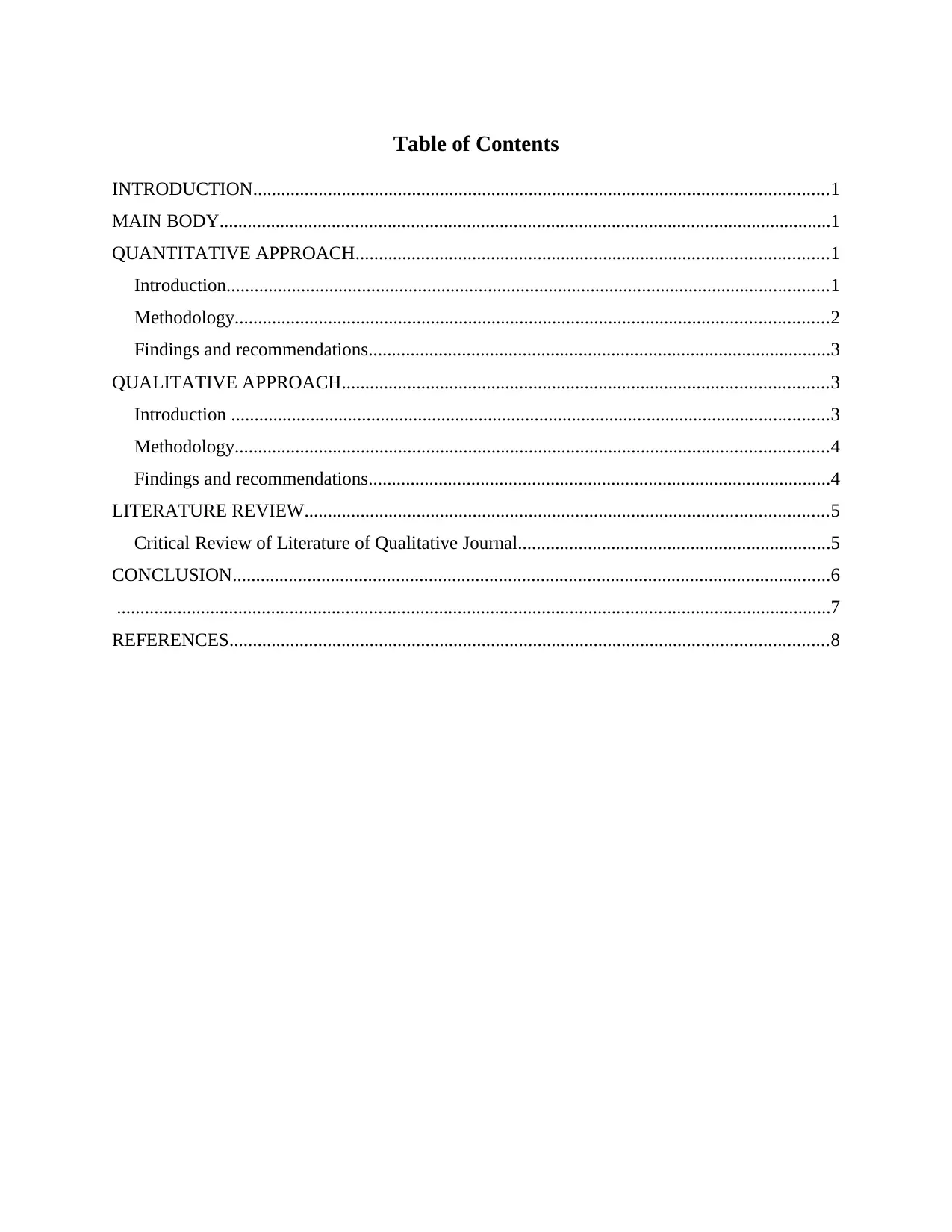
Table of Contents
INTRODUCTION...........................................................................................................................1
MAIN BODY...................................................................................................................................1
QUANTITATIVE APPROACH.....................................................................................................1
Introduction.................................................................................................................................1
Methodology...............................................................................................................................2
Findings and recommendations...................................................................................................3
QUALITATIVE APPROACH........................................................................................................3
Introduction ................................................................................................................................3
Methodology...............................................................................................................................4
Findings and recommendations...................................................................................................4
LITERATURE REVIEW................................................................................................................5
Critical Review of Literature of Qualitative Journal...................................................................5
CONCLUSION................................................................................................................................6
.........................................................................................................................................................7
REFERENCES................................................................................................................................8
INTRODUCTION...........................................................................................................................1
MAIN BODY...................................................................................................................................1
QUANTITATIVE APPROACH.....................................................................................................1
Introduction.................................................................................................................................1
Methodology...............................................................................................................................2
Findings and recommendations...................................................................................................3
QUALITATIVE APPROACH........................................................................................................3
Introduction ................................................................................................................................3
Methodology...............................................................................................................................4
Findings and recommendations...................................................................................................4
LITERATURE REVIEW................................................................................................................5
Critical Review of Literature of Qualitative Journal...................................................................5
CONCLUSION................................................................................................................................6
.........................................................................................................................................................7
REFERENCES................................................................................................................................8

⊘ This is a preview!⊘
Do you want full access?
Subscribe today to unlock all pages.

Trusted by 1+ million students worldwide
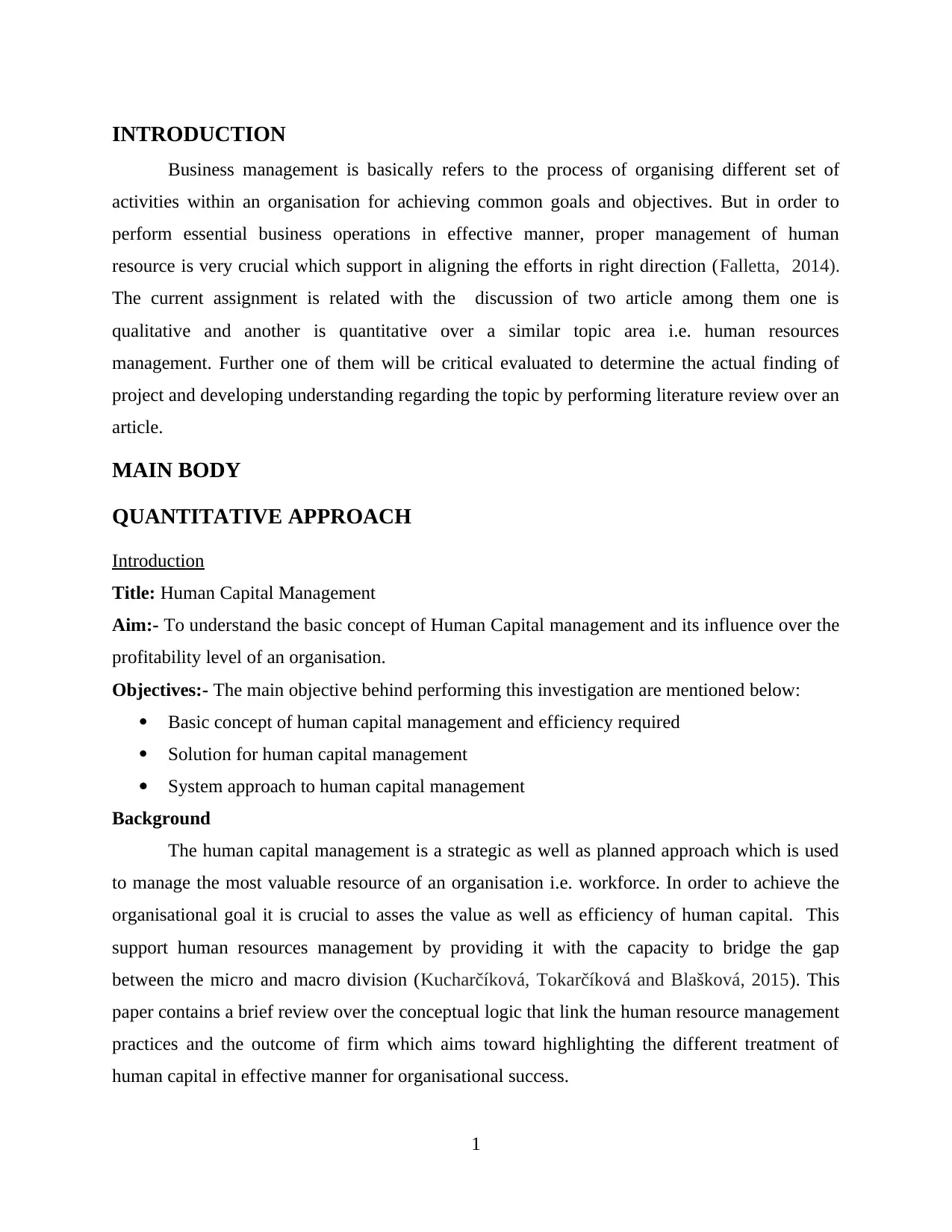
INTRODUCTION
Business management is basically refers to the process of organising different set of
activities within an organisation for achieving common goals and objectives. But in order to
perform essential business operations in effective manner, proper management of human
resource is very crucial which support in aligning the efforts in right direction (Falletta, 2014).
The current assignment is related with the discussion of two article among them one is
qualitative and another is quantitative over a similar topic area i.e. human resources
management. Further one of them will be critical evaluated to determine the actual finding of
project and developing understanding regarding the topic by performing literature review over an
article.
MAIN BODY
QUANTITATIVE APPROACH
Introduction
Title: Human Capital Management
Aim:- To understand the basic concept of Human Capital management and its influence over the
profitability level of an organisation.
Objectives:- The main objective behind performing this investigation are mentioned below:
Basic concept of human capital management and efficiency required
Solution for human capital management
System approach to human capital management
Background
The human capital management is a strategic as well as planned approach which is used
to manage the most valuable resource of an organisation i.e. workforce. In order to achieve the
organisational goal it is crucial to asses the value as well as efficiency of human capital. This
support human resources management by providing it with the capacity to bridge the gap
between the micro and macro division (Kucharčíková, Tokarčíková and Blašková, 2015). This
paper contains a brief review over the conceptual logic that link the human resource management
practices and the outcome of firm which aims toward highlighting the different treatment of
human capital in effective manner for organisational success.
1
Business management is basically refers to the process of organising different set of
activities within an organisation for achieving common goals and objectives. But in order to
perform essential business operations in effective manner, proper management of human
resource is very crucial which support in aligning the efforts in right direction (Falletta, 2014).
The current assignment is related with the discussion of two article among them one is
qualitative and another is quantitative over a similar topic area i.e. human resources
management. Further one of them will be critical evaluated to determine the actual finding of
project and developing understanding regarding the topic by performing literature review over an
article.
MAIN BODY
QUANTITATIVE APPROACH
Introduction
Title: Human Capital Management
Aim:- To understand the basic concept of Human Capital management and its influence over the
profitability level of an organisation.
Objectives:- The main objective behind performing this investigation are mentioned below:
Basic concept of human capital management and efficiency required
Solution for human capital management
System approach to human capital management
Background
The human capital management is a strategic as well as planned approach which is used
to manage the most valuable resource of an organisation i.e. workforce. In order to achieve the
organisational goal it is crucial to asses the value as well as efficiency of human capital. This
support human resources management by providing it with the capacity to bridge the gap
between the micro and macro division (Kucharčíková, Tokarčíková and Blašková, 2015). This
paper contains a brief review over the conceptual logic that link the human resource management
practices and the outcome of firm which aims toward highlighting the different treatment of
human capital in effective manner for organisational success.
1
Paraphrase This Document
Need a fresh take? Get an instant paraphrase of this document with our AI Paraphraser
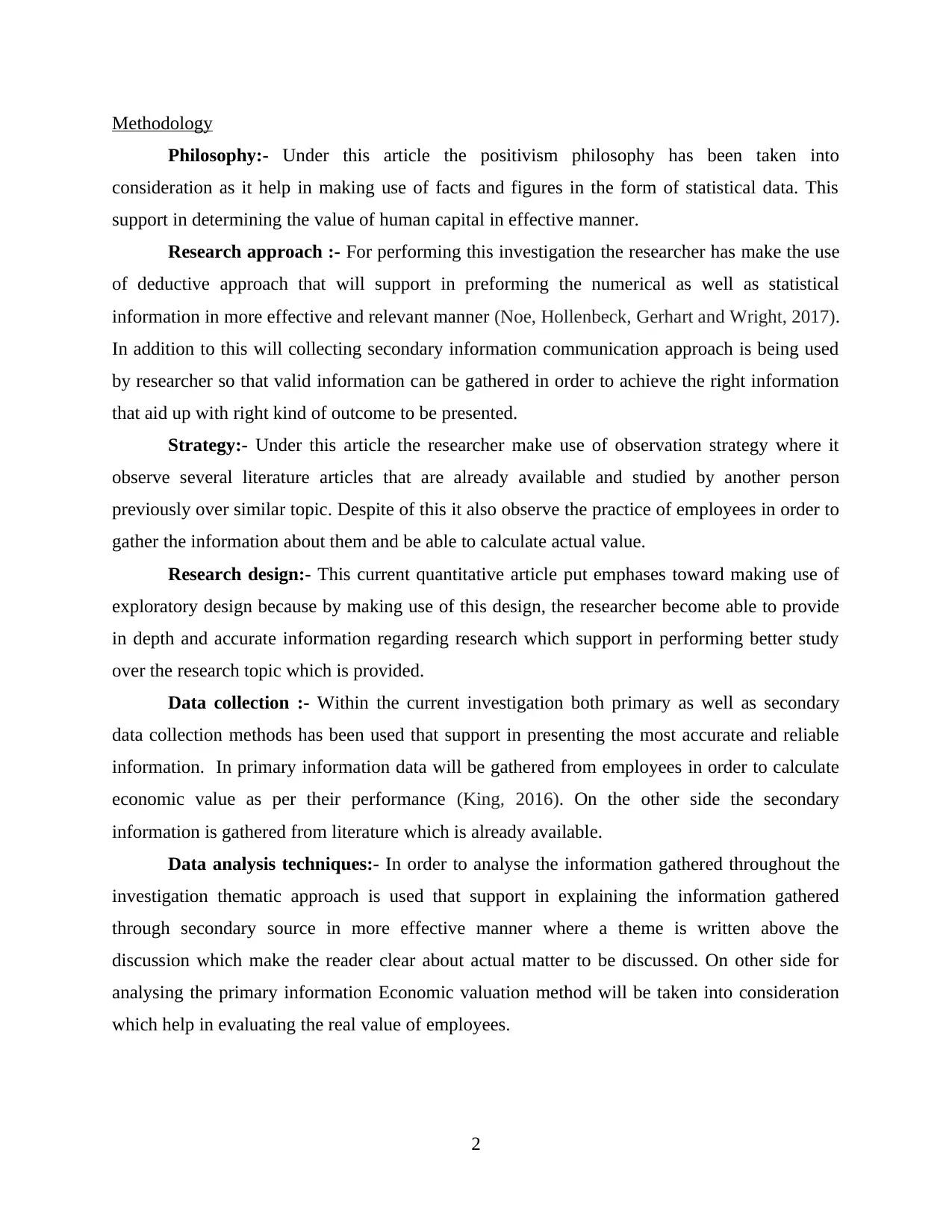
Methodology
Philosophy:- Under this article the positivism philosophy has been taken into
consideration as it help in making use of facts and figures in the form of statistical data. This
support in determining the value of human capital in effective manner.
Research approach :- For performing this investigation the researcher has make the use
of deductive approach that will support in preforming the numerical as well as statistical
information in more effective and relevant manner (Noe, Hollenbeck, Gerhart and Wright, 2017).
In addition to this will collecting secondary information communication approach is being used
by researcher so that valid information can be gathered in order to achieve the right information
that aid up with right kind of outcome to be presented.
Strategy:- Under this article the researcher make use of observation strategy where it
observe several literature articles that are already available and studied by another person
previously over similar topic. Despite of this it also observe the practice of employees in order to
gather the information about them and be able to calculate actual value.
Research design:- This current quantitative article put emphases toward making use of
exploratory design because by making use of this design, the researcher become able to provide
in depth and accurate information regarding research which support in performing better study
over the research topic which is provided.
Data collection :- Within the current investigation both primary as well as secondary
data collection methods has been used that support in presenting the most accurate and reliable
information. In primary information data will be gathered from employees in order to calculate
economic value as per their performance (King, 2016). On the other side the secondary
information is gathered from literature which is already available.
Data analysis techniques:- In order to analyse the information gathered throughout the
investigation thematic approach is used that support in explaining the information gathered
through secondary source in more effective manner where a theme is written above the
discussion which make the reader clear about actual matter to be discussed. On other side for
analysing the primary information Economic valuation method will be taken into consideration
which help in evaluating the real value of employees.
2
Philosophy:- Under this article the positivism philosophy has been taken into
consideration as it help in making use of facts and figures in the form of statistical data. This
support in determining the value of human capital in effective manner.
Research approach :- For performing this investigation the researcher has make the use
of deductive approach that will support in preforming the numerical as well as statistical
information in more effective and relevant manner (Noe, Hollenbeck, Gerhart and Wright, 2017).
In addition to this will collecting secondary information communication approach is being used
by researcher so that valid information can be gathered in order to achieve the right information
that aid up with right kind of outcome to be presented.
Strategy:- Under this article the researcher make use of observation strategy where it
observe several literature articles that are already available and studied by another person
previously over similar topic. Despite of this it also observe the practice of employees in order to
gather the information about them and be able to calculate actual value.
Research design:- This current quantitative article put emphases toward making use of
exploratory design because by making use of this design, the researcher become able to provide
in depth and accurate information regarding research which support in performing better study
over the research topic which is provided.
Data collection :- Within the current investigation both primary as well as secondary
data collection methods has been used that support in presenting the most accurate and reliable
information. In primary information data will be gathered from employees in order to calculate
economic value as per their performance (King, 2016). On the other side the secondary
information is gathered from literature which is already available.
Data analysis techniques:- In order to analyse the information gathered throughout the
investigation thematic approach is used that support in explaining the information gathered
through secondary source in more effective manner where a theme is written above the
discussion which make the reader clear about actual matter to be discussed. On other side for
analysing the primary information Economic valuation method will be taken into consideration
which help in evaluating the real value of employees.
2
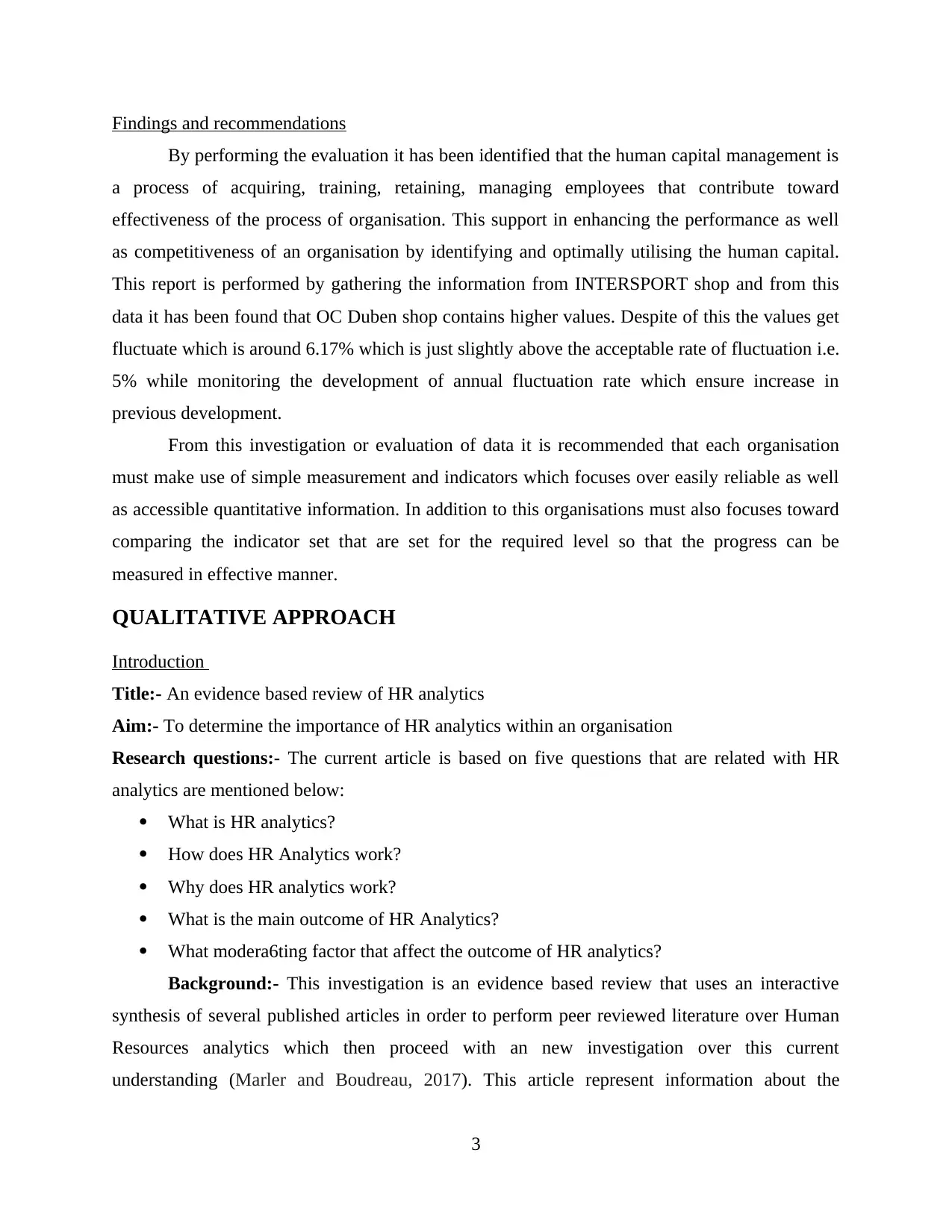
Findings and recommendations
By performing the evaluation it has been identified that the human capital management is
a process of acquiring, training, retaining, managing employees that contribute toward
effectiveness of the process of organisation. This support in enhancing the performance as well
as competitiveness of an organisation by identifying and optimally utilising the human capital.
This report is performed by gathering the information from INTERSPORT shop and from this
data it has been found that OC Duben shop contains higher values. Despite of this the values get
fluctuate which is around 6.17% which is just slightly above the acceptable rate of fluctuation i.e.
5% while monitoring the development of annual fluctuation rate which ensure increase in
previous development.
From this investigation or evaluation of data it is recommended that each organisation
must make use of simple measurement and indicators which focuses over easily reliable as well
as accessible quantitative information. In addition to this organisations must also focuses toward
comparing the indicator set that are set for the required level so that the progress can be
measured in effective manner.
QUALITATIVE APPROACH
Introduction
Title:- An evidence based review of HR analytics
Aim:- To determine the importance of HR analytics within an organisation
Research questions:- The current article is based on five questions that are related with HR
analytics are mentioned below:
What is HR analytics?
How does HR Analytics work?
Why does HR analytics work?
What is the main outcome of HR Analytics?
What modera6ting factor that affect the outcome of HR analytics?
Background:- This investigation is an evidence based review that uses an interactive
synthesis of several published articles in order to perform peer reviewed literature over Human
Resources analytics which then proceed with an new investigation over this current
understanding (Marler and Boudreau, 2017). This article represent information about the
3
By performing the evaluation it has been identified that the human capital management is
a process of acquiring, training, retaining, managing employees that contribute toward
effectiveness of the process of organisation. This support in enhancing the performance as well
as competitiveness of an organisation by identifying and optimally utilising the human capital.
This report is performed by gathering the information from INTERSPORT shop and from this
data it has been found that OC Duben shop contains higher values. Despite of this the values get
fluctuate which is around 6.17% which is just slightly above the acceptable rate of fluctuation i.e.
5% while monitoring the development of annual fluctuation rate which ensure increase in
previous development.
From this investigation or evaluation of data it is recommended that each organisation
must make use of simple measurement and indicators which focuses over easily reliable as well
as accessible quantitative information. In addition to this organisations must also focuses toward
comparing the indicator set that are set for the required level so that the progress can be
measured in effective manner.
QUALITATIVE APPROACH
Introduction
Title:- An evidence based review of HR analytics
Aim:- To determine the importance of HR analytics within an organisation
Research questions:- The current article is based on five questions that are related with HR
analytics are mentioned below:
What is HR analytics?
How does HR Analytics work?
Why does HR analytics work?
What is the main outcome of HR Analytics?
What modera6ting factor that affect the outcome of HR analytics?
Background:- This investigation is an evidence based review that uses an interactive
synthesis of several published articles in order to perform peer reviewed literature over Human
Resources analytics which then proceed with an new investigation over this current
understanding (Marler and Boudreau, 2017). This article represent information about the
3
⊘ This is a preview!⊘
Do you want full access?
Subscribe today to unlock all pages.

Trusted by 1+ million students worldwide
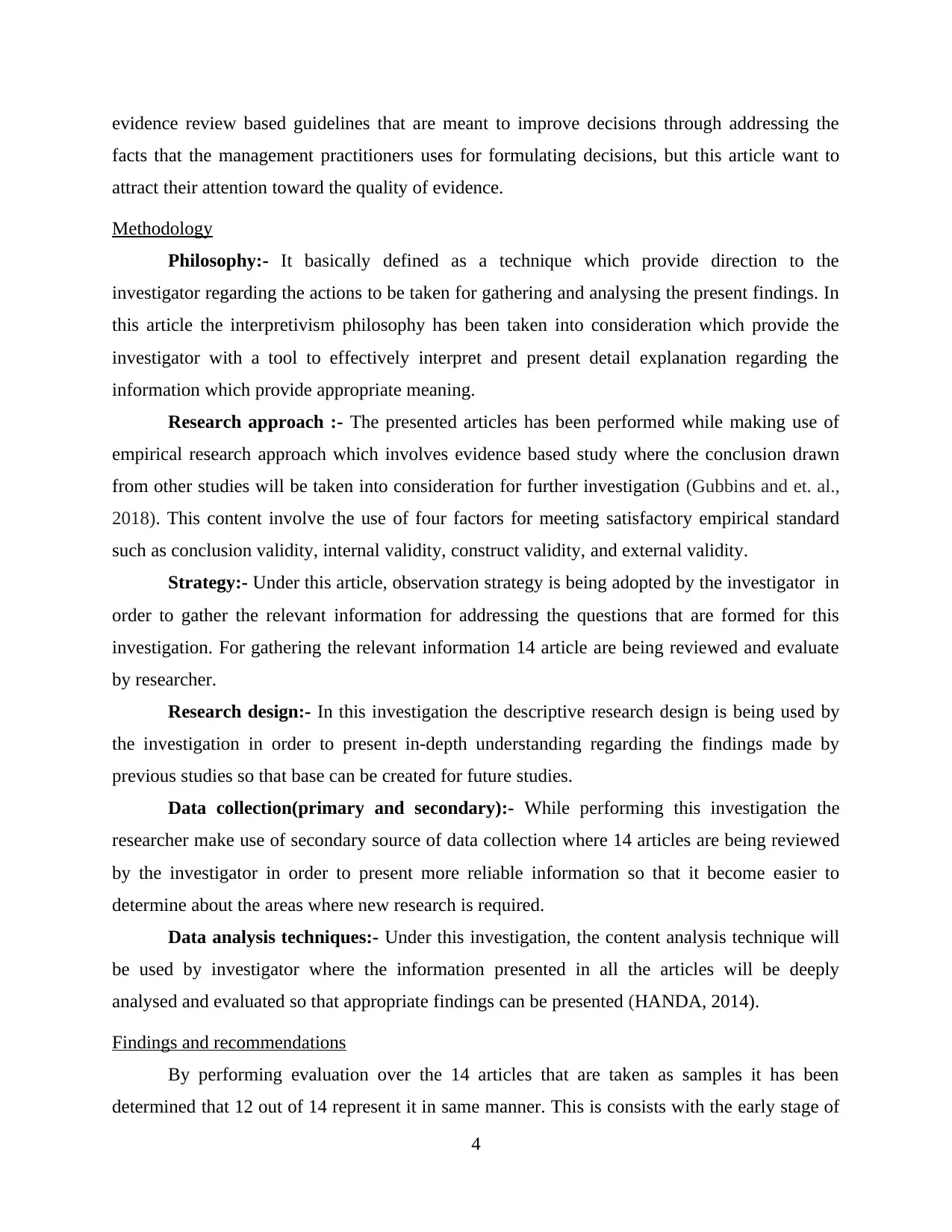
evidence review based guidelines that are meant to improve decisions through addressing the
facts that the management practitioners uses for formulating decisions, but this article want to
attract their attention toward the quality of evidence.
Methodology
Philosophy:- It basically defined as a technique which provide direction to the
investigator regarding the actions to be taken for gathering and analysing the present findings. In
this article the interpretivism philosophy has been taken into consideration which provide the
investigator with a tool to effectively interpret and present detail explanation regarding the
information which provide appropriate meaning.
Research approach :- The presented articles has been performed while making use of
empirical research approach which involves evidence based study where the conclusion drawn
from other studies will be taken into consideration for further investigation (Gubbins and et. al.,
2018). This content involve the use of four factors for meeting satisfactory empirical standard
such as conclusion validity, internal validity, construct validity, and external validity.
Strategy:- Under this article, observation strategy is being adopted by the investigator in
order to gather the relevant information for addressing the questions that are formed for this
investigation. For gathering the relevant information 14 article are being reviewed and evaluate
by researcher.
Research design:- In this investigation the descriptive research design is being used by
the investigation in order to present in-depth understanding regarding the findings made by
previous studies so that base can be created for future studies.
Data collection(primary and secondary):- While performing this investigation the
researcher make use of secondary source of data collection where 14 articles are being reviewed
by the investigator in order to present more reliable information so that it become easier to
determine about the areas where new research is required.
Data analysis techniques:- Under this investigation, the content analysis technique will
be used by investigator where the information presented in all the articles will be deeply
analysed and evaluated so that appropriate findings can be presented (HANDA, 2014).
Findings and recommendations
By performing evaluation over the 14 articles that are taken as samples it has been
determined that 12 out of 14 represent it in same manner. This is consists with the early stage of
4
facts that the management practitioners uses for formulating decisions, but this article want to
attract their attention toward the quality of evidence.
Methodology
Philosophy:- It basically defined as a technique which provide direction to the
investigator regarding the actions to be taken for gathering and analysing the present findings. In
this article the interpretivism philosophy has been taken into consideration which provide the
investigator with a tool to effectively interpret and present detail explanation regarding the
information which provide appropriate meaning.
Research approach :- The presented articles has been performed while making use of
empirical research approach which involves evidence based study where the conclusion drawn
from other studies will be taken into consideration for further investigation (Gubbins and et. al.,
2018). This content involve the use of four factors for meeting satisfactory empirical standard
such as conclusion validity, internal validity, construct validity, and external validity.
Strategy:- Under this article, observation strategy is being adopted by the investigator in
order to gather the relevant information for addressing the questions that are formed for this
investigation. For gathering the relevant information 14 article are being reviewed and evaluate
by researcher.
Research design:- In this investigation the descriptive research design is being used by
the investigation in order to present in-depth understanding regarding the findings made by
previous studies so that base can be created for future studies.
Data collection(primary and secondary):- While performing this investigation the
researcher make use of secondary source of data collection where 14 articles are being reviewed
by the investigator in order to present more reliable information so that it become easier to
determine about the areas where new research is required.
Data analysis techniques:- Under this investigation, the content analysis technique will
be used by investigator where the information presented in all the articles will be deeply
analysed and evaluated so that appropriate findings can be presented (HANDA, 2014).
Findings and recommendations
By performing evaluation over the 14 articles that are taken as samples it has been
determined that 12 out of 14 represent it in same manner. This is consists with the early stage of
4
Paraphrase This Document
Need a fresh take? Get an instant paraphrase of this document with our AI Paraphraser
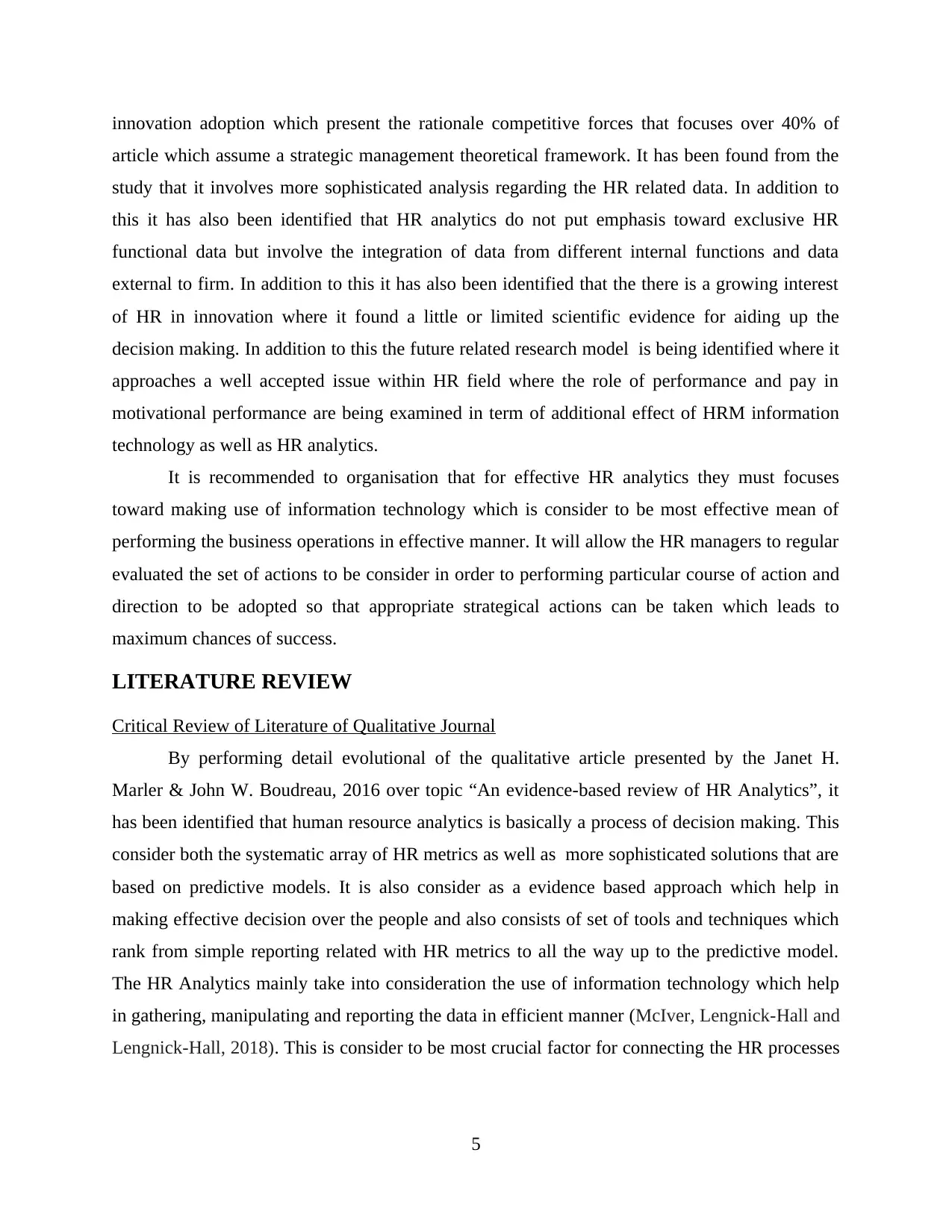
innovation adoption which present the rationale competitive forces that focuses over 40% of
article which assume a strategic management theoretical framework. It has been found from the
study that it involves more sophisticated analysis regarding the HR related data. In addition to
this it has also been identified that HR analytics do not put emphasis toward exclusive HR
functional data but involve the integration of data from different internal functions and data
external to firm. In addition to this it has also been identified that the there is a growing interest
of HR in innovation where it found a little or limited scientific evidence for aiding up the
decision making. In addition to this the future related research model is being identified where it
approaches a well accepted issue within HR field where the role of performance and pay in
motivational performance are being examined in term of additional effect of HRM information
technology as well as HR analytics.
It is recommended to organisation that for effective HR analytics they must focuses
toward making use of information technology which is consider to be most effective mean of
performing the business operations in effective manner. It will allow the HR managers to regular
evaluated the set of actions to be consider in order to performing particular course of action and
direction to be adopted so that appropriate strategical actions can be taken which leads to
maximum chances of success.
LITERATURE REVIEW
Critical Review of Literature of Qualitative Journal
By performing detail evolutional of the qualitative article presented by the Janet H.
Marler & John W. Boudreau, 2016 over topic “An evidence-based review of HR Analytics”, it
has been identified that human resource analytics is basically a process of decision making. This
consider both the systematic array of HR metrics as well as more sophisticated solutions that are
based on predictive models. It is also consider as a evidence based approach which help in
making effective decision over the people and also consists of set of tools and techniques which
rank from simple reporting related with HR metrics to all the way up to the predictive model.
The HR Analytics mainly take into consideration the use of information technology which help
in gathering, manipulating and reporting the data in efficient manner (McIver, Lengnick-Hall and
Lengnick-Hall, 2018). This is consider to be most crucial factor for connecting the HR processes
5
article which assume a strategic management theoretical framework. It has been found from the
study that it involves more sophisticated analysis regarding the HR related data. In addition to
this it has also been identified that HR analytics do not put emphasis toward exclusive HR
functional data but involve the integration of data from different internal functions and data
external to firm. In addition to this it has also been identified that the there is a growing interest
of HR in innovation where it found a little or limited scientific evidence for aiding up the
decision making. In addition to this the future related research model is being identified where it
approaches a well accepted issue within HR field where the role of performance and pay in
motivational performance are being examined in term of additional effect of HRM information
technology as well as HR analytics.
It is recommended to organisation that for effective HR analytics they must focuses
toward making use of information technology which is consider to be most effective mean of
performing the business operations in effective manner. It will allow the HR managers to regular
evaluated the set of actions to be consider in order to performing particular course of action and
direction to be adopted so that appropriate strategical actions can be taken which leads to
maximum chances of success.
LITERATURE REVIEW
Critical Review of Literature of Qualitative Journal
By performing detail evolutional of the qualitative article presented by the Janet H.
Marler & John W. Boudreau, 2016 over topic “An evidence-based review of HR Analytics”, it
has been identified that human resource analytics is basically a process of decision making. This
consider both the systematic array of HR metrics as well as more sophisticated solutions that are
based on predictive models. It is also consider as a evidence based approach which help in
making effective decision over the people and also consists of set of tools and techniques which
rank from simple reporting related with HR metrics to all the way up to the predictive model.
The HR Analytics mainly take into consideration the use of information technology which help
in gathering, manipulating and reporting the data in efficient manner (McIver, Lengnick-Hall and
Lengnick-Hall, 2018). This is consider to be most crucial factor for connecting the HR processes
5
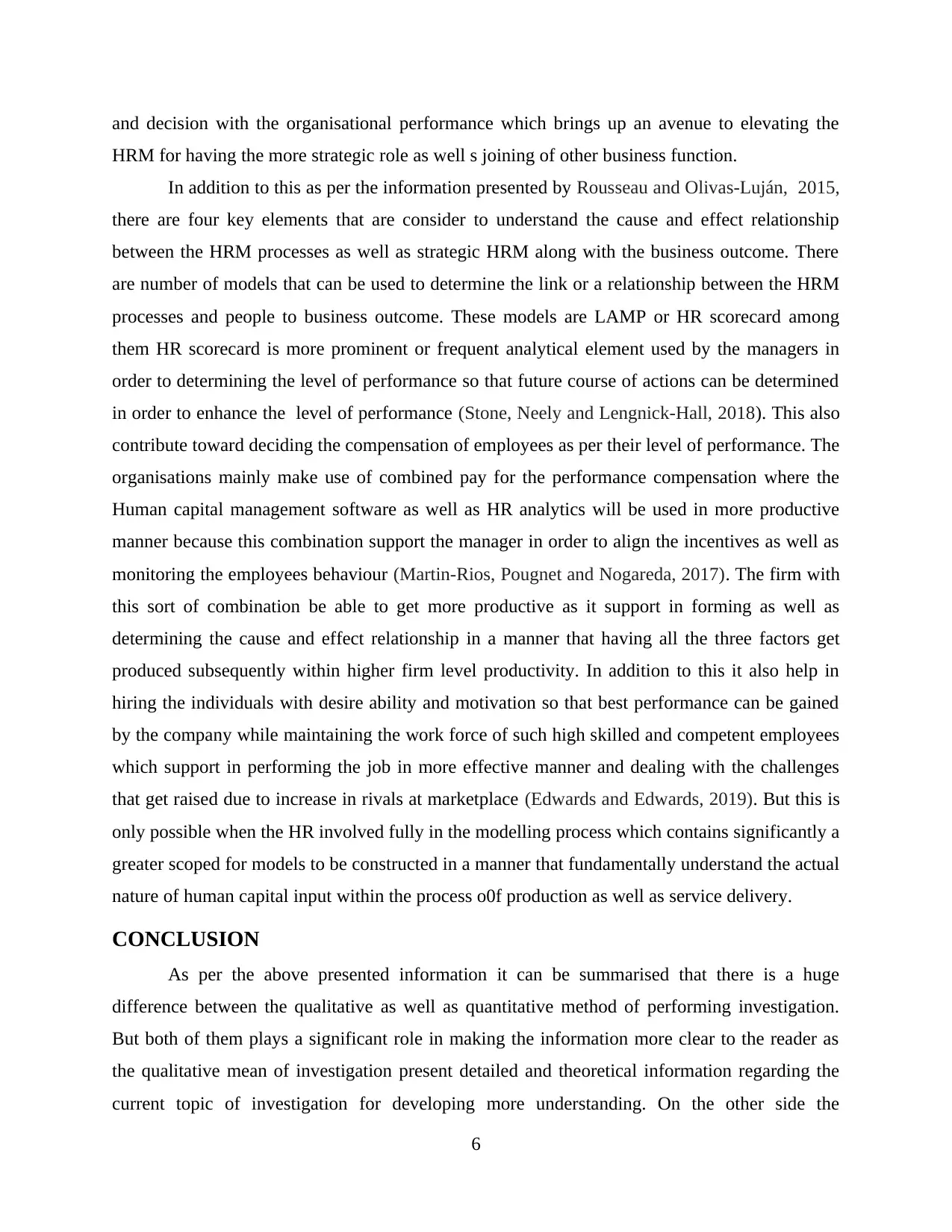
and decision with the organisational performance which brings up an avenue to elevating the
HRM for having the more strategic role as well s joining of other business function.
In addition to this as per the information presented by Rousseau and Olivas‐Luján, 2015,
there are four key elements that are consider to understand the cause and effect relationship
between the HRM processes as well as strategic HRM along with the business outcome. There
are number of models that can be used to determine the link or a relationship between the HRM
processes and people to business outcome. These models are LAMP or HR scorecard among
them HR scorecard is more prominent or frequent analytical element used by the managers in
order to determining the level of performance so that future course of actions can be determined
in order to enhance the level of performance (Stone, Neely and Lengnick-Hall, 2018). This also
contribute toward deciding the compensation of employees as per their level of performance. The
organisations mainly make use of combined pay for the performance compensation where the
Human capital management software as well as HR analytics will be used in more productive
manner because this combination support the manager in order to align the incentives as well as
monitoring the employees behaviour (Martin-Rios, Pougnet and Nogareda, 2017). The firm with
this sort of combination be able to get more productive as it support in forming as well as
determining the cause and effect relationship in a manner that having all the three factors get
produced subsequently within higher firm level productivity. In addition to this it also help in
hiring the individuals with desire ability and motivation so that best performance can be gained
by the company while maintaining the work force of such high skilled and competent employees
which support in performing the job in more effective manner and dealing with the challenges
that get raised due to increase in rivals at marketplace (Edwards and Edwards, 2019). But this is
only possible when the HR involved fully in the modelling process which contains significantly a
greater scoped for models to be constructed in a manner that fundamentally understand the actual
nature of human capital input within the process o0f production as well as service delivery.
CONCLUSION
As per the above presented information it can be summarised that there is a huge
difference between the qualitative as well as quantitative method of performing investigation.
But both of them plays a significant role in making the information more clear to the reader as
the qualitative mean of investigation present detailed and theoretical information regarding the
current topic of investigation for developing more understanding. On the other side the
6
HRM for having the more strategic role as well s joining of other business function.
In addition to this as per the information presented by Rousseau and Olivas‐Luján, 2015,
there are four key elements that are consider to understand the cause and effect relationship
between the HRM processes as well as strategic HRM along with the business outcome. There
are number of models that can be used to determine the link or a relationship between the HRM
processes and people to business outcome. These models are LAMP or HR scorecard among
them HR scorecard is more prominent or frequent analytical element used by the managers in
order to determining the level of performance so that future course of actions can be determined
in order to enhance the level of performance (Stone, Neely and Lengnick-Hall, 2018). This also
contribute toward deciding the compensation of employees as per their level of performance. The
organisations mainly make use of combined pay for the performance compensation where the
Human capital management software as well as HR analytics will be used in more productive
manner because this combination support the manager in order to align the incentives as well as
monitoring the employees behaviour (Martin-Rios, Pougnet and Nogareda, 2017). The firm with
this sort of combination be able to get more productive as it support in forming as well as
determining the cause and effect relationship in a manner that having all the three factors get
produced subsequently within higher firm level productivity. In addition to this it also help in
hiring the individuals with desire ability and motivation so that best performance can be gained
by the company while maintaining the work force of such high skilled and competent employees
which support in performing the job in more effective manner and dealing with the challenges
that get raised due to increase in rivals at marketplace (Edwards and Edwards, 2019). But this is
only possible when the HR involved fully in the modelling process which contains significantly a
greater scoped for models to be constructed in a manner that fundamentally understand the actual
nature of human capital input within the process o0f production as well as service delivery.
CONCLUSION
As per the above presented information it can be summarised that there is a huge
difference between the qualitative as well as quantitative method of performing investigation.
But both of them plays a significant role in making the information more clear to the reader as
the qualitative mean of investigation present detailed and theoretical information regarding the
current topic of investigation for developing more understanding. On the other side the
6
⊘ This is a preview!⊘
Do you want full access?
Subscribe today to unlock all pages.

Trusted by 1+ million students worldwide
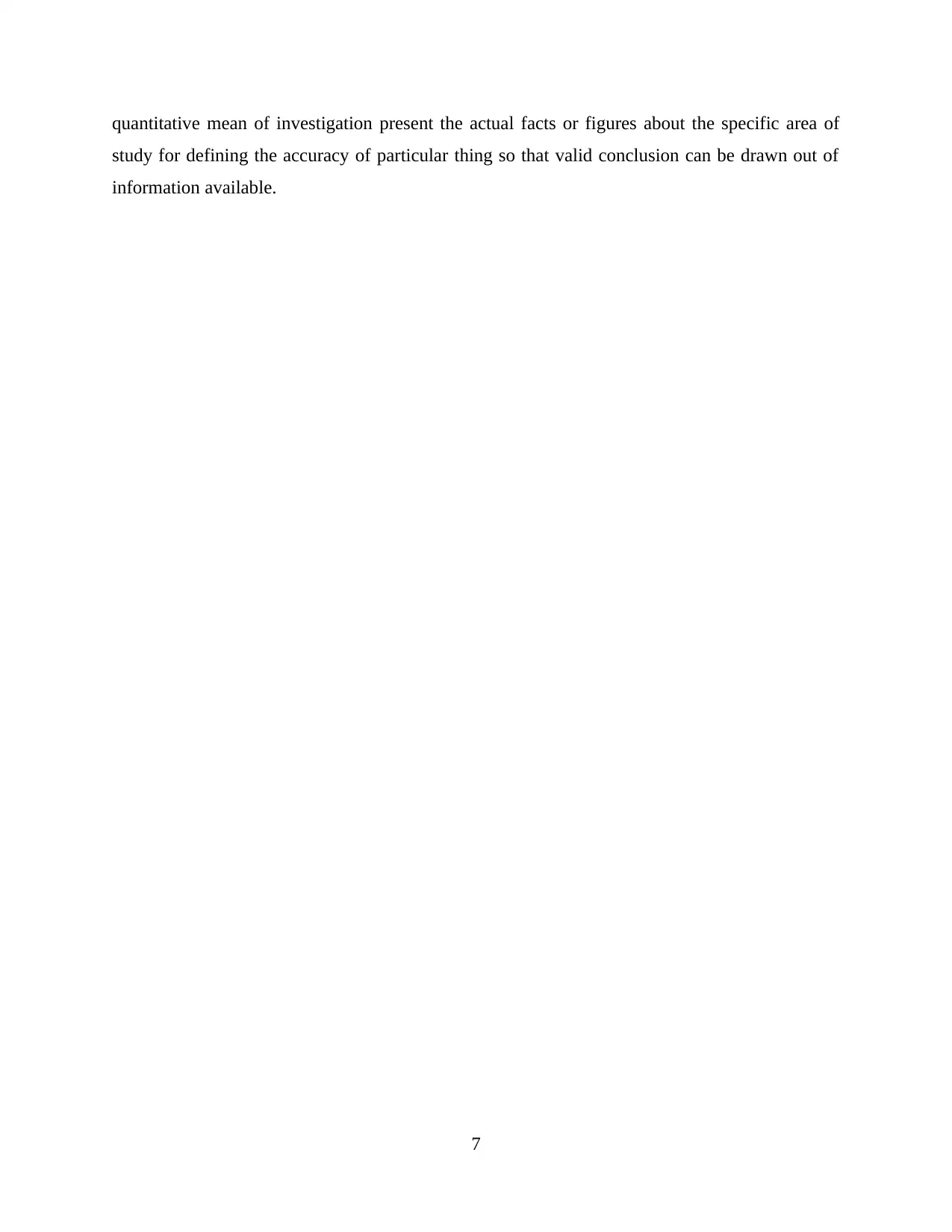
quantitative mean of investigation present the actual facts or figures about the specific area of
study for defining the accuracy of particular thing so that valid conclusion can be drawn out of
information available.
7
study for defining the accuracy of particular thing so that valid conclusion can be drawn out of
information available.
7
Paraphrase This Document
Need a fresh take? Get an instant paraphrase of this document with our AI Paraphraser
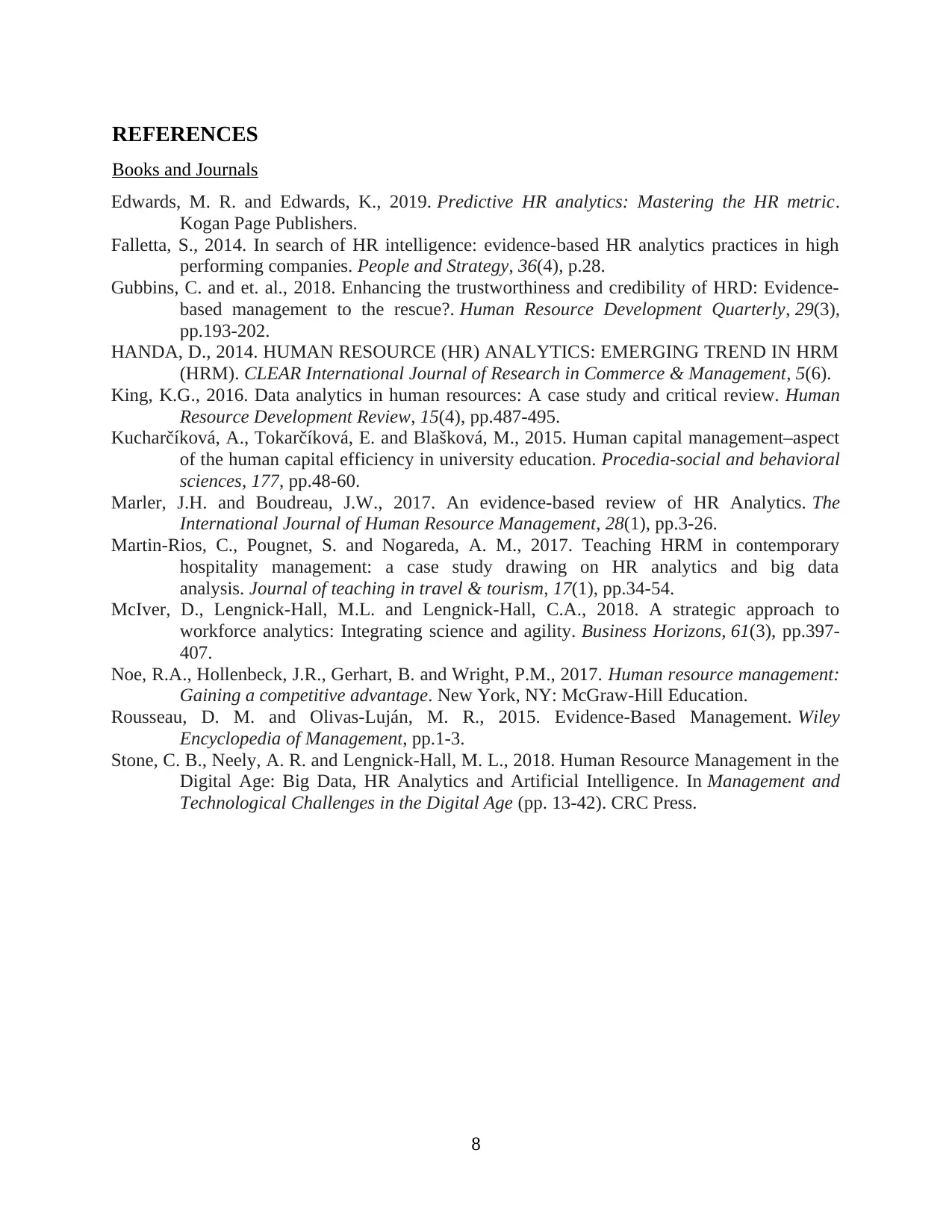
REFERENCES
Books and Journals
Edwards, M. R. and Edwards, K., 2019. Predictive HR analytics: Mastering the HR metric.
Kogan Page Publishers.
Falletta, S., 2014. In search of HR intelligence: evidence-based HR analytics practices in high
performing companies. People and Strategy, 36(4), p.28.
Gubbins, C. and et. al., 2018. Enhancing the trustworthiness and credibility of HRD: Evidence-
based management to the rescue?. Human Resource Development Quarterly, 29(3),
pp.193-202.
HANDA, D., 2014. HUMAN RESOURCE (HR) ANALYTICS: EMERGING TREND IN HRM
(HRM). CLEAR International Journal of Research in Commerce & Management, 5(6).
King, K.G., 2016. Data analytics in human resources: A case study and critical review. Human
Resource Development Review, 15(4), pp.487-495.
Kucharčíková, A., Tokarčíková, E. and Blašková, M., 2015. Human capital management–aspect
of the human capital efficiency in university education. Procedia-social and behavioral
sciences, 177, pp.48-60.
Marler, J.H. and Boudreau, J.W., 2017. An evidence-based review of HR Analytics. The
International Journal of Human Resource Management, 28(1), pp.3-26.
Martin-Rios, C., Pougnet, S. and Nogareda, A. M., 2017. Teaching HRM in contemporary
hospitality management: a case study drawing on HR analytics and big data
analysis. Journal of teaching in travel & tourism, 17(1), pp.34-54.
McIver, D., Lengnick-Hall, M.L. and Lengnick-Hall, C.A., 2018. A strategic approach to
workforce analytics: Integrating science and agility. Business Horizons, 61(3), pp.397-
407.
Noe, R.A., Hollenbeck, J.R., Gerhart, B. and Wright, P.M., 2017. Human resource management:
Gaining a competitive advantage. New York, NY: McGraw-Hill Education.
Rousseau, D. M. and Olivas‐Luján, M. R., 2015. Evidence‐Based Management. Wiley
Encyclopedia of Management, pp.1-3.
Stone, C. B., Neely, A. R. and Lengnick-Hall, M. L., 2018. Human Resource Management in the
Digital Age: Big Data, HR Analytics and Artificial Intelligence. In Management and
Technological Challenges in the Digital Age (pp. 13-42). CRC Press.
8
Books and Journals
Edwards, M. R. and Edwards, K., 2019. Predictive HR analytics: Mastering the HR metric.
Kogan Page Publishers.
Falletta, S., 2014. In search of HR intelligence: evidence-based HR analytics practices in high
performing companies. People and Strategy, 36(4), p.28.
Gubbins, C. and et. al., 2018. Enhancing the trustworthiness and credibility of HRD: Evidence-
based management to the rescue?. Human Resource Development Quarterly, 29(3),
pp.193-202.
HANDA, D., 2014. HUMAN RESOURCE (HR) ANALYTICS: EMERGING TREND IN HRM
(HRM). CLEAR International Journal of Research in Commerce & Management, 5(6).
King, K.G., 2016. Data analytics in human resources: A case study and critical review. Human
Resource Development Review, 15(4), pp.487-495.
Kucharčíková, A., Tokarčíková, E. and Blašková, M., 2015. Human capital management–aspect
of the human capital efficiency in university education. Procedia-social and behavioral
sciences, 177, pp.48-60.
Marler, J.H. and Boudreau, J.W., 2017. An evidence-based review of HR Analytics. The
International Journal of Human Resource Management, 28(1), pp.3-26.
Martin-Rios, C., Pougnet, S. and Nogareda, A. M., 2017. Teaching HRM in contemporary
hospitality management: a case study drawing on HR analytics and big data
analysis. Journal of teaching in travel & tourism, 17(1), pp.34-54.
McIver, D., Lengnick-Hall, M.L. and Lengnick-Hall, C.A., 2018. A strategic approach to
workforce analytics: Integrating science and agility. Business Horizons, 61(3), pp.397-
407.
Noe, R.A., Hollenbeck, J.R., Gerhart, B. and Wright, P.M., 2017. Human resource management:
Gaining a competitive advantage. New York, NY: McGraw-Hill Education.
Rousseau, D. M. and Olivas‐Luján, M. R., 2015. Evidence‐Based Management. Wiley
Encyclopedia of Management, pp.1-3.
Stone, C. B., Neely, A. R. and Lengnick-Hall, M. L., 2018. Human Resource Management in the
Digital Age: Big Data, HR Analytics and Artificial Intelligence. In Management and
Technological Challenges in the Digital Age (pp. 13-42). CRC Press.
8
1 out of 11
Related Documents
Your All-in-One AI-Powered Toolkit for Academic Success.
+13062052269
info@desklib.com
Available 24*7 on WhatsApp / Email
![[object Object]](/_next/static/media/star-bottom.7253800d.svg)
Unlock your academic potential
Copyright © 2020–2025 A2Z Services. All Rights Reserved. Developed and managed by ZUCOL.





